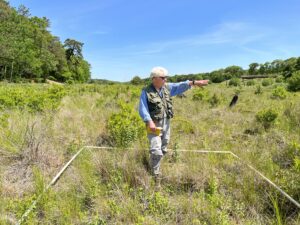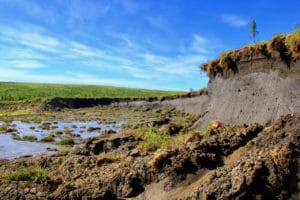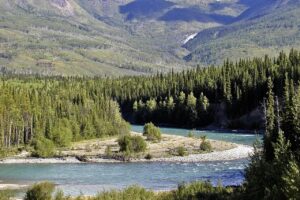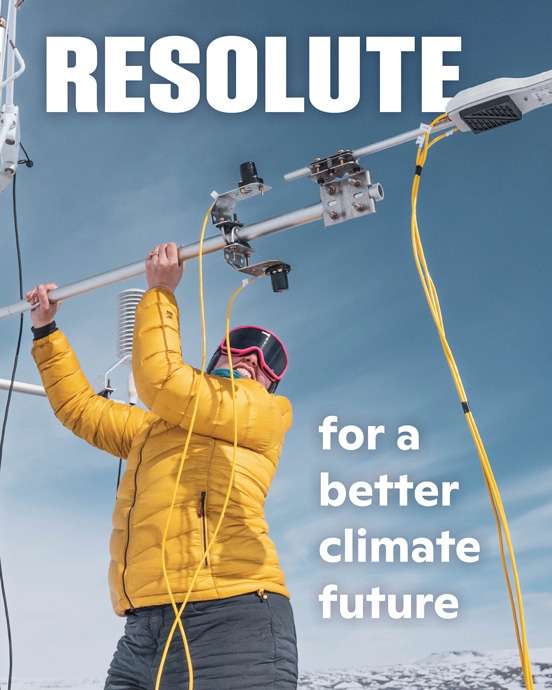Ecologist Neill honored with outstanding public service award

In his office at the Woodwell Climate Research Center, Christopher Neill’s framed Outstanding Public Service award from the Massachusetts Association of Conservation Commissions sat on a small table. When asked about his many accomplishments and accolades, Dr. Neill preferred to speak of the good work done by the organizations he works and volunteers with. He spoke highly of his peers at Woodwell and all the scientific groups he has collaborated with.
Dr. Neill is an environmental ecologist, studying natural ecosystems and the organisms that live in them.
Read more on The Falmouth Enterprise.
The polar vortex is acting weird and the US is paying the price this winter

It’s really, really cold again — as the US shivers through at least the eighth blast of air from the Arctic this winter.
Winter, which is warming faster than any other season for much of the US, seems to be making a comeback for the first time in years; this January was the coldest in the Lower 48 since 1988.
But the US is an outlier, and so is this winter. January was the warmest on record for the globe and, in a vast expanse of global warmth, the US sticks out like a cold, sore thumb.
From translating data into tools, to improving hazard management: Fund for Climate Solutions awards five new grants
The first round of 2025 Fund for Climate Solutions (FCS) awardees has been announced. The FCS advances innovative, solutions-oriented climate science through a competitive, internal, and cross-disciplinary funding process. Generous donor support has enabled us to raise more than $10 million towards the FCS, funding 74 research grants since 2018. Many of the latest cohort of grantees are translating data into tools for amplified impact. One project is bringing climate-related hazard expertise to at-risk communities, empowering them to co-create hazard management plans with their government officials.
A generic climate AI framework for multi-domain time series prediction
Lead: Dr. Yili Yang
Collaborators: Dr. Elchin Jafarov, Dr. Brendan Rogers, Dogukan Teber, Dr. José Lucas Safanelli, Dr. Andrea Castanho, Dr. Christopher Schwalm, Dominick Dusseau, Dr. Marcia Macedo, Dr. Jonathan Sanderman, Dr. Anna Liljedahl, Dr. Sue Natali, Dr. Michael Coe
Current climate science relies heavily on physics-based numerical models to make a wide range of predictions—from thawing permafrost in the Arctic, to tropical fires in the Brazilian Amazon, to soil carbon budgets of pastures, and risks associated with flooding. These types of models require an intense amount of computing power, and are expensive to run enough times to test a variety of detailed scenarios and assumptions. Researchers often need to simplify the models or the questions they are asking, limiting the insights that they can extract. To address this problem, the project team will use deep learning to develop a Center-wide AI framework for climate data that encompasses data from across regions and projects, reducing computational costs and energy demands. This new framework will have the potential to transform the ability of all Woodwell Climate researchers to provide policymakers with rapid, accurate predictions that support urgent climate response strategies.
Climate and Indigenous-centered boreal wildfire risk assessment
Lead: Dr. Kayla Mathes
Collaborators: Dr. Brendan Rogers and Dr. Peter Frumhoff
While fire has always been an important part of boreal ecosystems, fires that reach beyond historical patterns on the landscape are posing widespread consequences for climate, Indigenous sovereignty, and public health. Through our partnerships with land managers and community leaders in Alaska, Woodwell Climate researchers have identified two key barriers to responsive management and policy action: 1) Fire managers currently lack maps that identify areas with both a high probability of wildfire, and a high carbon emission potential from burning and permafrost thaw. 2) Current fire management priorities do not adequately include Indigenous knowledge and community needs. This project will generate two maps to address boreal fire management knowledge gaps. The team will create one map representing wildfire carbon vulnerability, and will also work with Yukon Flats Indigenous communities to co-produce a regionally-specific map that identifies their wildfire management needs and priorities.
Forms and functions of soil organic carbon
Lead: Dr. Jonathan Sanderman
Collaborators: Dr. José Lucas Safanelli, Dr. Ludmila Rattis, Dr. Christopher Neill
Not all carbon is created equal—some forms of carbon are easier for microbes to break down, while others are more persistent. In soils, scientists are typically interested in a few specific forms of organic carbon, but each type has a different decay rate. Measuring the amount of each type of carbon—referred to as fractions—in a soil sample is currently labor intensive, sometimes requiring highly specialized equipment. Woodwell Climate researchers recently proved that a 60-second, low-cost spectroscopy scan can provide similar information on soil carbon fractions to days of work with traditional methods. However, this scan relies on machine learning or deep learning algorithms and high-quality, geographically appropriate training datasets. This project will build an open-source database of soil carbon fraction data, along with freely-available models to predict soil carbon fractions using spectroscopy, hosted by the Woodwell-led Open Soil Spectral Library and Estimation Service. This groundbreaking solution offers a transformative approach to soil carbon monitoring—making soil carbon fraction prediction more widely accessible to labs around the world.
Empowering the Tropical Forests Forever Facility with a tool for informed decision-making
Lead: Dr. Glenn Bush
Collaborators: Kathleen Savage, Patrick Fedor, Emily Sturdivant, Dr. Wayne Walker, Dr. Ludmila Rattis, Dr. Michael Coe
The Tropical Forests Forever Facility (TFFF), is an initiative spearheaded by the Government of Brazil to establish a US$125 billion global investment fund. If successfully established, TFFF can generate long-term finance to provide ongoing annual compensation to tropical forest nations to conserve intact tropical forests. The fund now needs to build confidence amongst potential sponsors to demonstrate feasible pathways to impact. The project team will create a new location-based dataset of cost-effective forest conservation options for the Democratic Republic of Congo (DRC) and Brazil, where Woodwell researchers have a long history of relationships and expertise. This dataset will provide valuable information around what forest conservation strategies will be effective, and where, based on financial and social benefits to people in the target landscapes. Ultimately, the team will be able to concretely identify how much forest conservation can be achieved with a given budget, and where to target efforts to resolve the highest-priority risks. With this information, the TFFF can demonstrate the effectiveness of the program and incentivize participation of sponsor countries and tropical forest nations.
Landslide hazard management workshops in Homer and Seward, Alaska
Lead: Dr. Anna Liljedahl
Collaborator: Dr. Jennifer Francis
Extreme rain events, glacier retreat, and permafrost thaw are making landslides and landslide-generated tsunamis in Alaska more likely. However, these hazards are not well-integrated into land and emergency management—for example, warning systems are relatively non-existent. The project team will host workshops in two Alaska communities at risk for landslides and landslide-generated tsunamis to raise awareness about the threats among residents and public agencies, and to identify landslide hazard management practices. The workshops will bring together experts in science and hazard mitigation; city, borough, and state officials; and community members to jointly develop recommendations for action. This effort builds on the ongoing work of Dr. Liljedahl’s project, Arctic Tsunamigenic Slope Instabilities Partnership (Arctic T-SLIP), and will support a future group of research proposals to the National Science Foundation on landslides and landslide-generated tsunami hazards. Insights gained from these workshops will also add detail to a Woodwell Climate Just Access risk report completed for Homer in 2021.
Despite thorough preparations, flying the drone is still nervewracking.
Dr. Manoela Machado, a Research Scientist at Woodwell Climate, has double- and triple- checked her calculated flight path over a study plot in the Cerrado, Brazil’s natural savanna. The drone can essentially fly itself, and she’ll be monitoring its speed, altitude, and battery life from her handheld controller on the ground, but many things could still go wrong. High winds, an unforeseen obstruction, loss of connectivity— all could jeopardize the mission, potentially dropping the expensive equipment 40 meters into the woodland canopy below.
Aboard Machado’s drone sits a powerful piece of technology – a LiDAR sensor. Developed originally for use in meteorology, this remote sensing technique now has widespread applications across scientific fields, from archaeology, to urban planning, to climate science. At Woodwell Climate, Machado and others employ LiDAR to create detailed three dimensional models of landscapes, which provide valuable insight into the structure of ecosystems and the amount of carbon stored in them— all with just a few (million) pulses of light.
What is LiDAR?
LiDAR stands for Light Detection and Ranging. Put simply, it is a sensor that uses laser light to measure distance.
Similar to other technologies like sonar and radar, which use sound and radio waves, respectively, LiDAR is an example of an “active” sensor. “Passive” sensors like cameras collect ambient light, while LiDAR actively pings the environment with beams of laser light and records the time those beams take to bounce back. The longer the return time, the further away an object is. That distance measurement is then used to calculate the precise location in three-dimensional space for each reflection.
This process is repeated millions of times during a single scan, resulting in a dense cloud of point locations. With some advanced computing, the data can be assembled into a 3D picture of the landscape.
“It’s effectively three dimensional pointillism,” says Woodwell Climate Chief Scientific Officer, Dr. Wayne Walker, who has been using LiDAR in his studies for 25 years.
Far more detailed than an oil painting however, a LiDAR model can reconstruct nearly every leaf, twig, and anthill on a landscape.
“Once you construct that cloud of millions of points, you get to walk inside the forest again,” says Machado. “When you finish processing the data and see the cloud you go, ‘I remember that tree! I remember standing there!’ It’s mesmerizing.”
For a project like Machado’s, scanning a few dozen hectares, the sensor is usually placed on a drone. Larger study areas require sensors mounted on low-flying airplanes or even satellites, but for small ground-based applications there are sensors one can carry, mount on a tripod, or attach to a backpack. Some newer phone models even have LIDAR apps built in. Regardless of how LIDAR is deployed, it remains a straightforward method of data collection. Just point the sensor at what you want to scan and within minutes, you’ve captured the data for a detailed three-dimensional model of your area of interest.
Estimating the weight of a forest
What Machado and Walker are often after from a LiDAR scan is a measurement of biomass, or the total weight of the organic matter present in an ecosystem. Plants store carbon in the form of organic matter, so biomass measurements are an easy way to estimate an area’s carbon storage.
However, measuring a forest’s biomass directly would require cutting down all the trees, drying them out, and weighing what’s left — impractical and needlessly destructive— so scientists use proxy measurements. Walker likens the process to trying to estimate the weight of a human without access to a scale.
“What are the measurements you might use if you couldn’t actually physically measure weight? You might record height, waist size, inseam, and if you obtain enough of these measurements you can start to build a model that relates them to weight,” says Walker. “That’s what we’re trying to do when we estimate the biomass of an entire forest.”
Raw LiDAR data is only a measurement of distance, but by classifying each point based on its location relative to the cloud, researchers are able to extract the proxy measurements needed to model biomass across the ecosystem. Before LiDAR, these proxy measurements— things like trunk diameter, height, and tree species— had to be recorded entirely by hand, which limits data collection based on human time and resources. The time-saving addition of LiDAR has vastly expanded the possible scale of study plots. While field measurements are still essential to calibrate models, LiDAR is one of the only technologies that can give scientists enough detail and scope to assess carbon stocks over entire ecosystems.
“There is no other kind of sensor that even comes close to LiDAR,” says Walker.
The power and potential of LiDAR
At Woodwell Climate, researchers have employed the power of LiDAR to map biomass and carbon from Brazilian forests, to the Arctic tundra. Outside of the Center, the technology has found applications in archaeological surveys, lane detection for self-driving cars, and topographical mapping down to a resolution of half a meter.
But the detail that makes LiDAR so powerful can also make the data a challenge to work with. A single scan produces millions of data points. According to Geospatial Analyst and Research Associate, Emily Sturdivant, who analyzed LiDAR data for Woodwell’s Climate Smart Martha’s Vineyard project, that wealth of data often overwhelms our ability to extract the full potential of information available in one point cloud.
“LiDAR creates so much data that when you look at it, it’s hard not to be blown away imagining all the different things you could do with it. But then reality kicks in,” says Sturdivant. “It’s challenging to take full advantage of all those points with our current processing power. It’s a matter of the analysis technology catching up with the data.”
Processing LiDAR data requires large amounts of computing time and storage space, especially when performing more complex analyses like segmenting the data on the scale of individual trees. As machine learning and cloud computing technologies advance however, this becomes less of an obstacle, and the potential insights from LiDAR datasets will advance along with them.
LiDAR can be an expensive endeavor, too. Drones with the right equipment can cost tens of thousands of dollars, as can hiring a plane and pilot and paying for jet fuel, so data sharing has been important in making the method more cost effective. U.S. government agencies like NASA and the USGS have facilitated the collection of LiDAR data through satellites and plane flights, making the data available for public use. Woodwell Climate research has benefitted from these public datasets, using them to inform landscape studies and carbon flux models.
According to Sturdivant, the reliable production of public data has been greatly beneficial to advancing LiDAR-based studies, though it now faces risks from federal cuts to science agency funding.
“One of the greatest advantages of having publicly supported data is the consistency, but that’s exactly what’s now at risk,” says Sturdivant. “Public accessibility has been so important in allowing new scientists to learn and experiment and then help everyone else learn.”
Each new LiDAR scan represents a trove of information that could be used to better understand our changing planet, making it critical to continue supporting and collecting LiDAR data. Its intensely visual and highly detailed nature has made it one of the most powerful tools we have for understanding something as complex as a forest.
“And on top of that,” says Machado “It’s just visually beautiful.”
Update: How’s U.S. winter weather changing in a warming world?
Cold extremes are indeed waning over most of the midlatitude Northern Hemisphere, but a decade-plus debate on the Arctic’s role continues.

When a full-fledged snowstorm descended on the U.S. Gulf Coast in mid-January 2025, followed by a night of unprecedented cold across some bayous and beaches (see Part I of this two-part post), it did more than turn New Orleans and Mobile into winter wonderlands. It reignited a topic that’s cropped up again and again across science and media landscapes since the early 2010s: Is a warming Arctic affecting winter extremes over North America and Eurasia? And if so, how?
Read more on Yale Climate Connections.
The current state of the Arctic carbon cycle
New study on the Arctic carbon cycle provides important insights and highlights research needs

The Arctic plays a central role in the global climate system, particularly through its function as a carbon sink. However, climate change could disrupt its balance. An international research team headed by the Alfred Wegener Institute and the Vrije Universiteit Amsterdam has presented a comprehensive analysis of the current state of the Arctic carbon cycle. The results, which have been published in the scientific journal Nature Reviews Earth & Environment, provide new and updated numbers and highlight existing uncertainties.
Read more on The Max Planck Institute for Biogeochemistry website.
Scientists look to keep NWT’s huge carbon stores out of the air

Cutting human-driven greenhouse gas emissions is already proving tough in the North. Now, attention is turning to carbon within the land itself – an emissions problem that also needs solving and which could be hugely damaging.
Governments across Canada and the world have spent years trying to bring down the emissions we put out through our use of fossil fuels.
Yet targets are being missed and our world is still warming. As it does that, the likelihood increases that massive stores of carbon contained within our landscape will start to emerge into the air, making the overall problem worse.
Next week, scientists will gather in the Northwest Territories to talk about that.
Continue reading on Cabin Radio.




